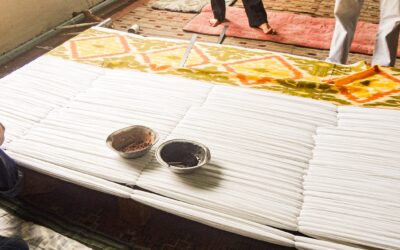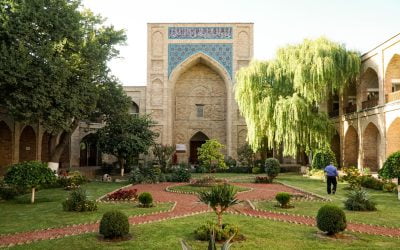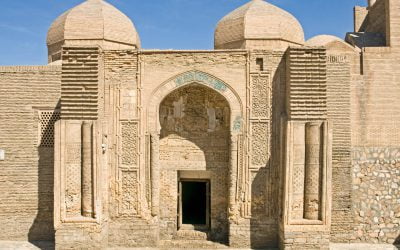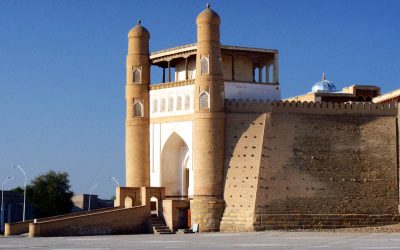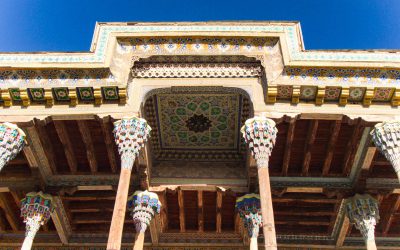PO-I KALYAN COMPLEX
How To Get There
The unmistakable minaret of Po-i Kalyan will lead any visitor to the complex as it led many travellers to the city of Bukhara before. The complex is situated on Khodja Nurobobod Street in the Old City. The Mir-i Arab Madrasah is situated directly across the road from it.
HERITAGE SITE | PO-I KALYAN COMPLEX
-
- The Poi Kalyon complex has been described as the ‘beating heart’ of the Old Town of Bukhara, and is the visual high point (both literal and metaphorical) of the city’s skyline.
- The title Po-i Kalan, which means ‘at the foot of the Great’, is derived from its place at the foot of the Kalyon Minaret, the tapering, mud-brick tower which rises gracefully some 45m above the city. The 12th-century Kalyan minaret is one of the most impressive monuments in Bukhara and is the most prominent landmark in the city.
- The minaret was built in 1127 by an architect named Bako during the reign of the Qarakhanid ruler Mohammad Arslan Khan. Bako ordered that the foundations be dug some 13m deep, and demanded the labourers use a special mortar that was mixed with bulls’ blood, camel milk and eggs. It took two years to set and certainly did work as the minaret still stands today, 800 years later, having not needed any restoration!
- The minaret was part of the Jumuah Musjid and was used for the daily calls to prayer. The architect Bako died not long after the minaret was completed, purportedly broken-hearted that it had failed to live up to his dreams.
- Genghis Khan however, looked upon it a little more favourably in the following century, having seen it for miles as he rode across the steppe and been suitably impressed, he spared the tower when all around it was razed. It was literally the only building left standing when he left the city.
- Today, visitors may climb up the 104 steps of the brick spiral staircase that twists up inside around the pillar. The view from the top is undeniably the best one will experience of the city.
Kalyan Musjid
- The original 8th-century Kalyan Musjid was the one in which Genghis Khan ordered that the pages of the Quran be trampled beneath the feet of his horses and the entirety of Bukhara be destroyed. The musjid was burnt to a cinder. The replacement, a worthy successor, is also known as the Jumuah or Friday Musjid and was built by the Shaybanids in 1514. Since then it has served as the city’s main musjid being able to accommodate over 10,000 worshippers which was the entire male population of the city at the time of its construction.
- The musjid has a beautiful spacious courtyard which is surrounded by 208 columns and 288 domes. The most prominent dome is the Kok Gumbaz (Blue Dome) beneath which lies the gilded mihrab (prayer niche) as well as an unusual octagonal structure designed to improve the building’s acoustics, amplifying the voice of the Imam as he conveys his Friday sermon.
- Having been used as a warehouse during the Soviet period, the Kalyon Musjid reopened to worshippers in 1991. It continues to be a place of prayer, albeit on a fraction of the scale for which it was originally intended.
Mir-i Arab Madrasah
- Opposite the musjid is the Mir-i Arab Madrasah, which was constructed by the Shaybanid Ubaydullah Khan in 1535. His endowment is considered one of the most important educational establishments of the Islamic world. The madrasah was named ‘Mir-i Arab’ (Prince of the Arabs) after Sheikh Abdullah of Yemen who was the spiritual advisor of several rulers including Ubaydullah Khan.
- It is reported that Imam Bukhari RA taught at this madrasah for some time.
- This particular madrasah amazingly remained fully functional since its inception till today with the only exception being the 21-year period from 1925-1946. It was even allowed on a small scale, for political reasons, during the Soviet era.
- The madrasah still functions today and houses around 180 students from Uzbekistan and around Central Asia.


